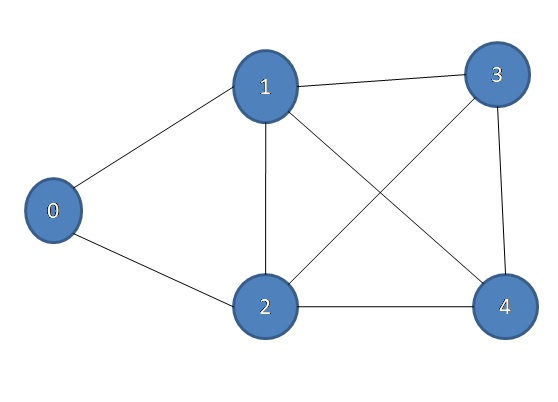哈密顿路径
Problem Statement:
问题陈述:
Given a graph G. you have to find out that that graph is Hamiltonian or not.
给定图G。 您必须找出该图是否为哈密顿量 。
Example:
例:
Input:
输入:

Output: 1
输出1
Because here is a path 0 → 1 → 5 → 3 → 2 → 0 and 0 → 2 → 3 → 5 → 1 → 0
因为这里是路径0→1→5→3→2→0和0→2→3→5→1→0
Algorithm:
算法:
To solve this problem we follow this approach:
为了解决这个问题,我们采用以下方法:
We take the source vertex and go for its adjacent not visited vertices.
我们获取源顶点,并寻找其相邻的未访问顶点。
Whenever we find a new vertex we make it source vertex and we repeat step 1.
每当我们找到一个新顶点时,就将其设为源顶点,然后重复步骤1。
When a vertex count is equal to the vertex number then we check that from vertex is there any path to the source vertex. If there is exist a path to the source vertex then we will mark it and if not then make that vertex as unmarked and continue the process.
当顶点数等于顶点数时,我们检查从顶点开始是否存在到源顶点的任何路径。 如果存在到源顶点的路径,那么我们将对其进行标记,如果没有,则将该顶点设为未标记并继续该过程。
If there is no such path then we say NO.
如果没有这样的路径,那么我们说不。
检查图是否为哈密顿的C ++实现 (C++ Implementation to check a graph is Hamiltonian or not )
#include <iostream>
#include <bits/stdc++.h>
using namespace std;
void addedge(list<int>* g, int u, int v)
{
g[u].push_back(v);
g[v].push_back(u);
}
int hamiltonian(list<int>* g, int v, int s, int& count, bool* vis, int& h)
{
if (count > 1 && s == 0) {
h = 1;
return 1;
}
list<int>::iterator it;
for (it = g[s].begin(); it != g[s].end(); it++) {
if (!vis[*it]) {
vis[*it] = true;
count++;
if (count == v) {
vis[0] = false;
}
hamiltonian(g, v, *it, count, vis, h);
vis[0] = true;
vis[*it] = false;
count--;
}
}
return 0;
}
int main()
{
int num;
cin >> num;
for (int i = 0; i < num; i++) {
int v, e;
cin >> v >> e;
list<int> g[v];
int x, y;
for (int j = 0; j < e; j++) {
cin >> x >> y;
addedge(g, x, y);
}
bool vis[v];
memset(vis, false, sizeof(vis));
int count = 1;
vis[0] = true;
int h = 0;
hamiltonian(g, v, 0, count, vis, h);
cout << h << endl;
}
return 0;
}
Output
输出量
1
5
8
0 1
0 2
1 2
1 3
1 4
3 4
3 2
2 4
1
翻译自: https://www.includehelp.com/icp/check-a-graph-is-hamiltonian-or-not-hamiltonian-path.aspx
哈密顿路径







方法与示例)

)

方法(带示例))







![[计算机网络]httpserver--如何解析HTTP请求报文](http://pic.xiahunao.cn/[计算机网络]httpserver--如何解析HTTP请求报文)